I slept well in the comfortable surroundings of the Hotel Moe, Kalay. Breakfast was in an open-sided restaurant on the fifth floor, reached by a lift. Breakfast was laid out buffet style and items were even labelled in English. There was an Egg Station attended by a young girl and a 6-slice ‘Dualit’ toaster. It was clear that the Hotel Moe was bidding for International Travellers so I was unsurprised when three young European tourists came in , although it had been a few days since I’d seen anyone not from Myanmar. There is a small airport here so it’s relatively easy for tourists to reach Kalay by the scheduled service from Yangon. The Doctor had already ordered an omelette for me with a side dish of steamed rice. The Doctor and his wife enjoyed chicken, fish and vegetable dishes with their rice. My companions enjoyed help-yourself coffee whilst I was able to make a cup of Lipton’s tea with milk powder and a little sugar.
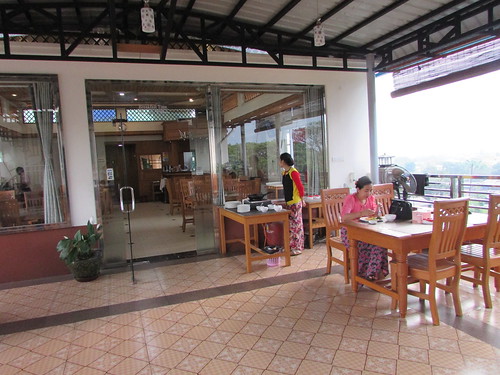
Trip to Tamu 2nd May 2018: Dining Room at Hotel Moe, Kalay.
With the Monastery car awaiting a replacement air bag for the rear suspension, the Doctor had arranged to hire another car and driver so that our trip to Tamu could go ahead and at 8.45 a.m., a large Nissan saloon arrived. We loaded up and set off through the back streets stopping after a few minutes at a terrace of shops. We’d stopped at the sort of petrol station which used to be ubiquitous in Myanmar, without electric pumps, where fuel is transferred manually from a large plastic container using a tundish. Buying fuel is another area which has been transformed since I first came to Myanmar in 2008. Now, every main road has frequent, American-style filling stations. However, self-service has not been instituted and a gang of, usually young female, assistants ‘pump gas’. Generally, 92 RON, 95 RON and PREMIUM grades of petrol are available plus Diesel. Even our more modest traditional petrol station offered the three grades of petrol. Very quickly, we were on our way again, taking the road north to Tamu.
We’d already visited one border crossing with India at Rihkhawdar. In the north of Chin State, at Tamu, there is a second border crossing with India and that was our destination. In contrast with the unsealed mountainous road to Rihkhawdar, the road to Tamu is a tarmac road running across the plain almost level with long, straight sections straight for 131 km called the ‘India Myanmar Friendship Road’.
The only problem is negotiating more than 100 bridges over the various channels which pass through the plains. At this time of year, these are mainly dry or carrying little water but, when the rains come, prodigious volumes flow. Although there are some examples of modern reinforced concrete bridges which are wide, sealed with tarmac and provide little impediment to traffic flow, most of the bridges are either elderly large girder truss spans or truss bridges of the ‘Bailey’ bridge pattern. The larger girder truss bridges are almost certainly British and appear to have been delivered in ‘kit’ form and bolted together on site. The bridges have a carriageway just wide enough for a single vehicle so traffic in opposite directions has to implement an informal one-way system where the first vehicle to arrive at the bridge has priority. The vehicle deck sits on cross beams and is either a series of flat steel plates bolted to each truss or substantial wooden timbers similarly bolted in place. When in good condition, this arrangement is very satisfactory but these are old bridges (apart from a few apparently-recent ‘Bailey’ bridges) and most vehicle deck fixings are worn, loose or broken. As each vehicle crosses, the movement of steel deck plates produces a deafening clanging or, on wooden decks, the timbers jump around in an alarming manner, producing a loud clattering. There’s usually a gap between the roadway on the abutment on either side of the bridge and the vehicle deck so vehicles, particularly cars, have to ease on and off the bridge very slowly as first the front wheels then the rear lurch into the gap.
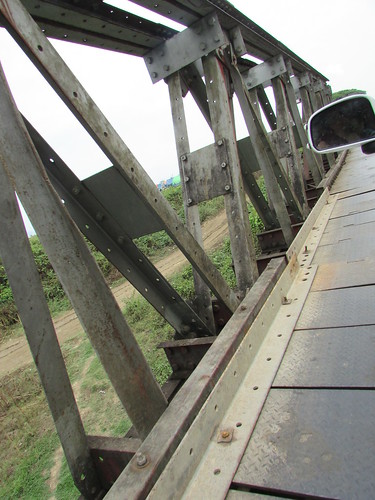
Trip to Tamu 2nd May 2018: Large girder truss span of bolted construction with steel decking in fairly good condition.
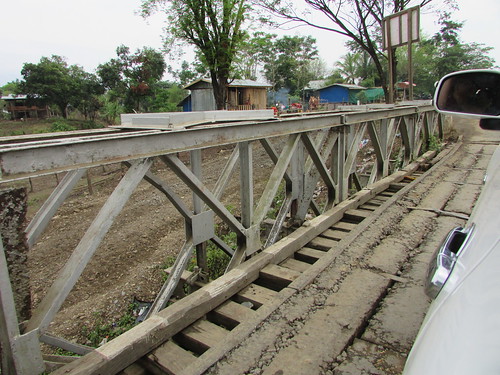
Trip to Tamu 2nd May 2018: A Bailey Bridge with a once-tarmaced wooden deck
Despite these problems, we made good progress, passing through a series of villages which each gave fleeting glimpses of life in Myanmar. This part of Myanmar was largely converted to Christianity and I’ve still not become used to the proliferation of Christian churches, although there were also Buddhist pagodas and monasteries. As we passed, I managed to identify some of the sects but there were lots more I either didn't see or couldn't read the signage. I identified Catholic, Baptist, Evangelical Baptist, Fundamental Baptist, Presbyterian, Presbyterian Kohhran, Christian Missionary Alliance and Believers' Church Myanmar.
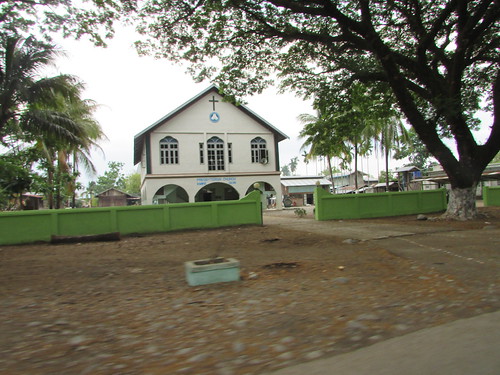
Trip to Tamu 2nd May 2018: Presbyterian Church, Khampat.
As we approached Tamu, it was clear that it was a town of some importance. Three big lorries we’d been following turned into some sort of Trading Zone, and I guessed that all the lorries to and from India cleared customs here.
We parked near the town centre and, as it was the appointed time for monks to take lunch, 11.30 a.m., we all went into a tea-shop where our monk was treated with great respect, seated at a separate table and plied with a range of foods. Afterwards, the Doctor, his wife and the writer were separately seated and our food was ordered.
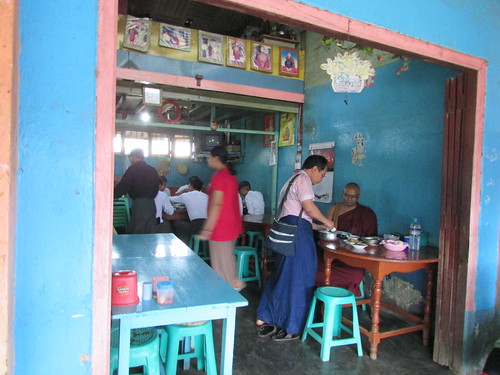
Trip to Tamu 2nd May 2018: Lunch at a teashop in Tamu.
When we’d all taken lunch, we walked to nearby Tamu Market. I never cease to be amazed by the range of products offered and the wide variety of fresh vegetables on offer at these markets.
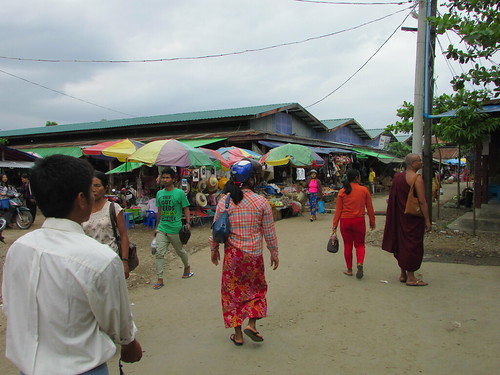
Trip to Tamu 2nd May 2018: Exploring Tamu Market.
One corner shop was selling a range of cosmetics under the Pond’s name. With a tastefully-lit glass-fronted display of products, a counter labelled “Pond’s Beauty Council” and a group of young, pretty assistants in matching uniforms (white top with black piping and black trousers), it all looked very professional.
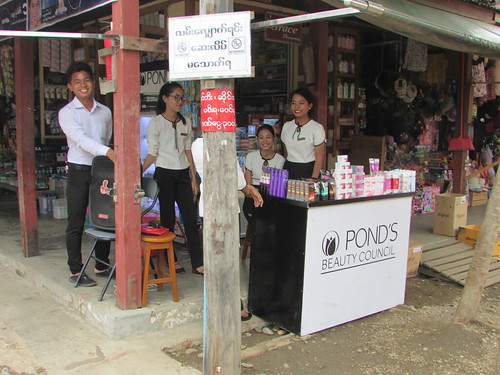
Trip to Tamu 2nd May 2018: Exploring Tamu Market: Pond's Beauty Council.
At the junction of two market streets, there was a deep well. The concrete top was marked ’15.4.07’ which I assume was the date and a simple beam overhead carried a pulley and cable for drawing water manually. A blue water pipe reaching down into the water appeared to be connected to an emergency water pump and fire hose.
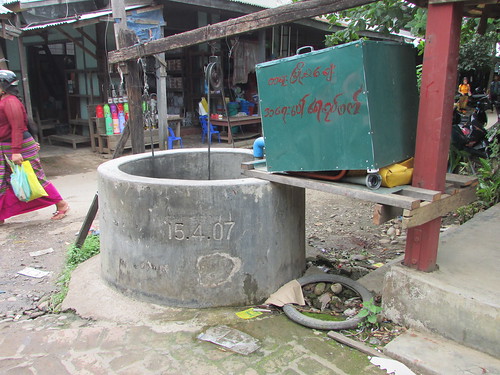
Trip to Tamu 2nd May 2018: Exploring Tamu Market. The Well.
A short distance away there was a lot of activity in what looked a pedestrian street lined with shops on both sides but the Doctor pointed out that this street led to the border crossing into India. Crowds of people were moving in both directions, a cosmopolitan combination of Indians and Myanmar people. Numerous boxes and sacks were being moved along the street by porters, some using big, two-wheeled carts who cleared pedestrians aside with their shouted warnings. But most of the porters I saw were women, who could balance three large boxes on their heads, apparently effortlessly, and then wend their way through the throng silently.
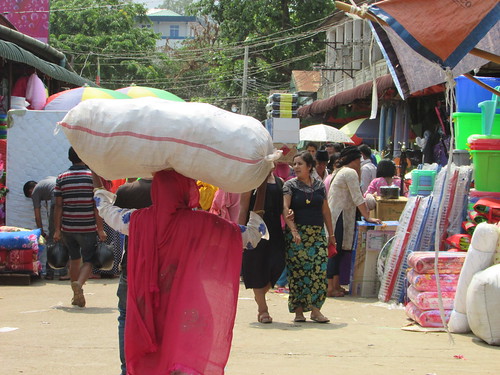
Trip to Tamu 2nd May 2018: the road to the Indian Border with an Indian lady porter.
At the end of the street, there was an Indian Immigration Checkpoint. Presentation of a Myanmar Identity Card gained entrance without further formality but I was unsurprised that my British Passport would require an interview with the Chief Immigration Officer and, without guarantee that permission would be quickly granted, I remained in Myanmar with the Doctor’s wife while the Doctor and the Monk made a brief visit to India. As well as the individual shops fronting the street, there was also a large covered market.
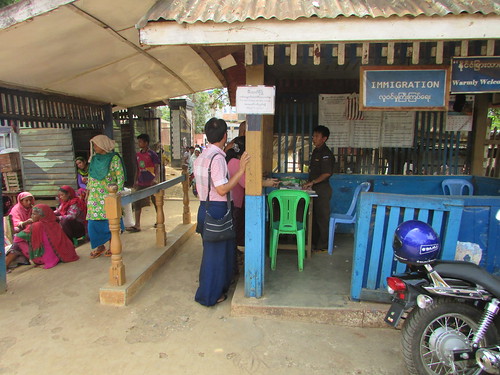
Trip to Tamu 2nd May 2018: The Indian Border Crossing for pedestrians at Tamu.
Having explored the market, I had a cold can of orange drink awaiting the Doctor’s return, upon which the Doctor and his wife had the milk from a fresh coconut. The vendor slices the top of the coconut with a vicious-looking panga, to expose the inside and the milk is drunk through a straw. When the milk is consumed, the vendor slices the coconut open to expose the soft, white flesh which can be torn off and eaten.
Having boarded our hired Nissan, we set off back along the ‘India Myanmar Friendship Road’. Part way along this road, we turned right to look at the Yazagyo Dam. Our driver assured us that its intended function was power generation although he admitted that was “for the future”.
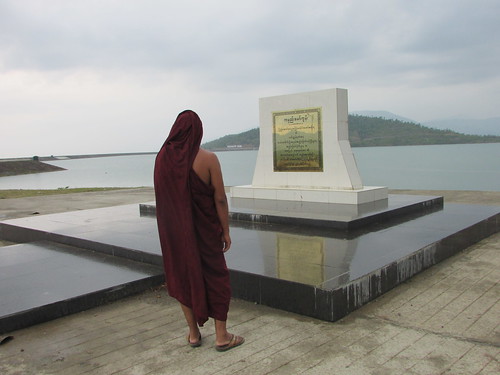
Trip to Tamu 2nd May 2018: Yazagyo Dam.
It was a pleasant spot and we were able to walk across the top of the Spillway.
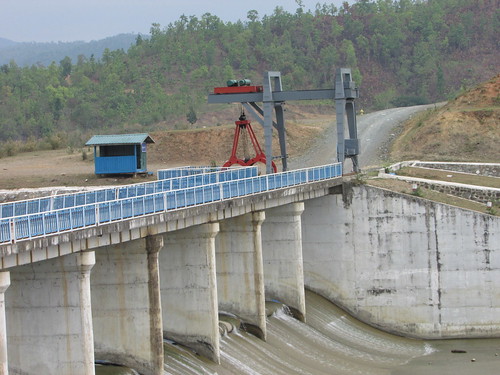
Trip to Tamu 2nd May 2018: Yazagyo Dam showing Spillway. The Gantry Crane is presumably for removing floating logs or flotsam.
The Doctor was the first to realise that the birds perched on the spillway were on the lookout for fish, swept out of the main lake.
We returned to the main road, continued south and then turned onto an unsealed road which we followed for some distance until we reached the modern temple called Gandhakuti Taik where a carved teak log presents four Buddha images.
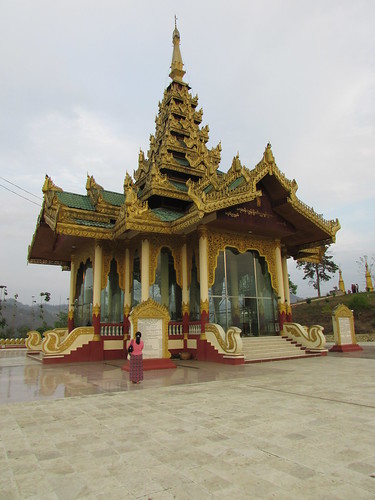
Trip to Tamu 2nd May 2018: Gandhakuti Taik on Raj Giri hill, housing the sacred carved teak log.
Our road now twisted and turned as it passed through a series of very rural villages. By this time, it was dark and I was completely bemused as to where we might be going. Then the car headlights picked out the recognisable gates of the Sel Taw Oo Monastery where we had spent one night earlier in our travels.
We were greeted warmly and told that dinner had been prepared for us just outside the monastery. I assumed that it would be at the rice mill house house where we’d had a meal when we first arrived, but it was at another, similar wooden house where the usual Myanmar Hospitality was extended to us.
After the meal, I expected us to return to our Kalaw Hotel by car but, instead, we were shepherded further along the lane on foot, with our car slowly following using its headlights to light the uneven stone roadway for us. We entered a second house which had a shop at the front and I was amazed to discover that we were at the home of our friends Ko Thein Shwe and Hlaing Hlaing Htay who had accompanied us the previous day to Rith Lake.
Most of the children were in another room but their ten-year old daughter came to sit by me and we both giggled, which we’d got quite good at on the Trip to Rith Lake. Food was again offered and we talked for a while.
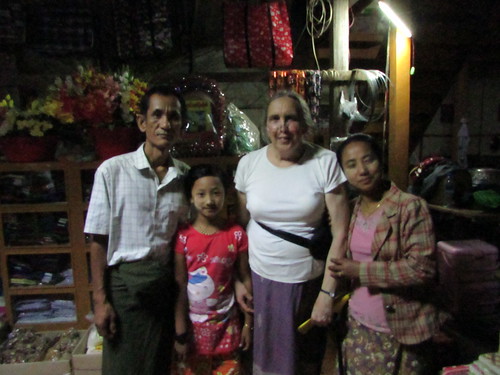
Trip to Tamu 2nd May 2018: A late evening visit to the home of Ko Thein Shwe and Hlaing Hlaing Htay.
A tropical rainstorm started as we said our “good byes” and even with umbrellas on hand, I was a bit wet by the time I sat in the car. Then I learnt that we had one more call to make, at the rice mill house.
By the time I was in the rice mill house, I was fairly wet. Then, I discovered that the Doctor was going to treat two of the family for long-term pain relief and a box of medication and paraphernalia was brought from the car. I’ve mentioned before that whilst, for instance, modesty in dress is important in Myanmar there is no concept of personal privacy so each treatment had an audience of eleven watching in fascination.
Treatments completed, we finally returned to the Hotel Moe after an absorbing, if long, day.
Related posts on this website
This is one of a series of posts describing my 13th visit to Myanmar.
The post Travelling again is the first post in the series.
Clicking on the 'Next report' link will show the post describing the next events. In this way, you may read about the trip in sequence.
Next report
Alternately, clicking on the 'All my Burma-2018 reports' link displays all the posts on this trip in reverse date-of-posting order.
All my Burma-2018 reports
My pictures
Trip to Tamu
Christian Churches in Myanmar
Hotel Moe, Kalay, Myanmar
All my pictures on this trip to Myanmar can be found at Burma 2018.
[Pictures linked 10-May-2018, minor edits and pictures embedded 11-Jun-2018]
